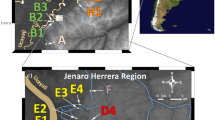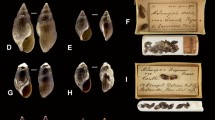Abstract
In Western Australia, populations of Artemia parthenogenetica in coastal salt lakes at Rottnest Island and Lake Hayward, and in salterns at Port Hedland and Shark Bay, are widely accepted to have been introduced by humans. Further, within the past 10 years, populations of A. parthenogenetica have been found in inland playa salt lakes in the wheatbelt of south-west Western Australia, where none had been recorded in previous salt lake studies. Here we hypothesise that birds act as transport vectors for Artemia cysts both within Australia and between the Asian and Australian continents. Allozyme analysis was used to identify clonal types (multi-locus genotypes), clonal frequencies, genotypic diversities and genotypic identity of six populations (three coastal, three inland).
Overall, the inland populations displayed almost identical genotypic structure to the coastal population from Lake Hayward, indicating that Lake Hayward could be the major source for dispersal and colonisation of inland populations. Results support the hypothesis of dispersal inland by nomadic bird species. Furthermore, evidence suggests that the inland and Lake Hayward populations may be an example of a metapopulation.
The greater variety of genotypes present in the Rottnest population indicates that this population has received a large number of small immigrations, or that it received one large introduction. The former may indicate a long period of suitable salinities, providing a greater time-span over which migration and succession of clonal types could occur in comparison to other populations. While we cannot rule out the possibility of human introduction of A. parthenogenetica to Rottnest, the hypothesis of cyst dispersal along the Austral-Asian flyway remains possible.
Similar content being viewed by others
References
Anon., 1999. “Shark Bay Salt Production” (CWR Contract Research), (Last updated 17.9.99), Available: http://www.cwr.uwa.edu.au/~contract/Current_projects/sharkbay.html (Accessed: 01.11.01).
Anon., 2001a. “Australian Dryland Salinity Assessment 2000: Western Australia” (Program of the Natural Heritage Trust, Commonwealth of Australia), (Last updated Jan 2001), Available: http://audit.ea.gov.au/ANRA/land/docs/national/Salinity_Contents.html (Accessed 13.12.02).
Anon., 2001b. “Salt” (Chamber of Minerals and Energy), Available: http://www.mineralswa.asn.au/~cmesalt/page2.html (Accessed: 02.11.01).
Abreu-Grobois, F. A. & J. A. Beardmore, 1980. International study on Artemia II. Genetic characterisation of Artemia populations – an electrophoretic approach. In Persoone, G., P. Sorgeloos, O. Roels & E. Jaspers (eds), The Brine Shrimp Artemia Vol. 1. Morphology, Genetics, Radiobiology, Toxicology. Universa Press, Wetteren, Belgium, 133–146.
Blakers, M., S. J. J. F. Davies & P. N. Reilly, 1984. The Atlas of Australian Birds. Melbourne University Press, Melbourne.
Browne, R. A., 1992. Population genetics and ecology of Artemia: insights into parthenogenetic reproduction. TREE 7: 232–237.
Browne, R. A. & C. Hoopes, 1990. Genotype diversity and selection in asexual brine shrimp (Artemia). Evolution 44: 1035–1051.
Clark, L. S. & S. T. Bowen, 1976. The genetics of Artemia salina VII. Reproductive isolation. Journal of Heredity 67: 385–388.
Edward, D. H. & J. A. L. Watson, 1959. Fresh water and brackish water swamps of Rottnest Island. Journal of the Royal Society of Western Australia 42: 85–86.
Elphick, J. (eds), 1995. Collins Atlas of Bird Migration: Tracing the Great Journeys of the World’s Birds. Harper Collins Publishers, United Kingdom.
Freeland, J. R., L. R. Noble & B. Okamura, 2000. Genetic consequences of the metapopulation biology of a facultatively sexual freshwater invertebrate. Journal of Evolutionary Biology 13: 383–395.
Geddes, M. C., 1979. Occurrence of the brine shrimp Artemia (Anostraca) in Australia. Crustaceana 36: 225–228.
Geddes, M. C., 1981. The brine shrimps Artemia and Parartemia. Comparative physiology and distribution in Australia. Hydrobiologia 81: 169–179.
Geddes, M. C. & W. D. Williams, 1987. Comments on Artemia introductions and the need for conservation. In Sorgeloos, P., D. A. Bengtson, W. Decleir & E. Jaspers (eds), Artemia Research and its Applications. Vol. 3. Ecology, Culturing, Use in Aquaculture. Universa Press, Wetteren, Belgium, 19–26.
Gilpin, M. E., 1991. The genetic effective size of a metapopulation. Biological Journal of the Linnean Society 42: 165–175.
Hebert, P. D. N. & M. J. Beaton, 1993. Methodologies for Allozyme Analysis Using Cellulose Acetate Electrophoresis. Department of Zoology, University of Guelph, Guelph, Ontario.
Higgins, P. J. & S. J. J. F. Davies (eds), 1996. Handbook of Australian, New Zealand & Antarctic Birds, Vols. 2&3. Oxford University Press, Melbourne.
Lawrence, C., 1993. The introduction and translocation of fish, crustaceans and molluscs in Western Australia. Fisheries Management Paper No. 58. Fisheries Department of Western Australia.
Jaensch, R. & R. Vervest, 1987. Waterbirds at Lake MacLeod and Shark Bay W.A. Western Australian Bird Notes 44: 1–3.
Levins, R., 1969. Some demographic and genetic consequences of environmental heterogeneity for biological control. Bulletin of the Entomological Society 15: 237–240.
Levins, R., 1970. Lecture notes on mathematics in the life sciences. In Gerstenhaber, M. (ed), Some Mathematical Questions in Biology. The American Mathematical Society, 75–107.
Mitchell, B. D. & M. C. Geddes, 1977. Distribution of the brine shrimps Parartemia zietziana Sayce and Artemia salina (L.) along a salinity and oxygen gradient in a South Australian saltfield. Freshwater Biology 7: 461–467.
Nei, M., 1972. Genetic distance between populations. American Naturalist 106: 283–293.
Pringle, J. D., 1987. The Shorebirds of Australia. Angus and Robertson Publishers, London.
Proctor, V. W. & C. R. Malone, 1965. Further evidence of the dispersal of small aquatic organisms via the intestinal tract of birds. Ecology 46: 728–729.
Richardson, B. J., P. R. Baverstock & M. Adams, 1986. Allozyme Electrophoresis. Academic Press, Sydney.
Sayce, O. A., 1903. The Phyllopoda of Australia, including descriptions of some new genera and species. Proceedings of the Royal Society of Victoria, 15: 224–261 + 10 plates.
Stoddart, J. A., 1983. A genotypic diversity measure. Journal of Heredity 74: 489–490.
Vanhaecke, P., W. Tackaert & P. Sorgeloos, 1987. The biogeography of Artemia: an updated review. In Sorgeloos, P., D. A. Bengtson, W. Decleir & E. Jaspers (eds), Artemia Research and its Applications, Vol. 1. Universa Press, Wetteren, Belgium: 129–155.
Author information
Authors and Affiliations
Corresponding author
Additional information
Guest Editor: John M. Melack
Saline Waters and their Biota
Rights and permissions
About this article
Cite this article
McMaster, K., Savage, A., Finston, T. et al. The recent spread of Artemia parthenogenetica in Western Australia. Hydrobiologia 576, 39–48 (2007). https://doi.org/10.1007/s10750-006-0291-0
Issue Date:
DOI: https://doi.org/10.1007/s10750-006-0291-0




